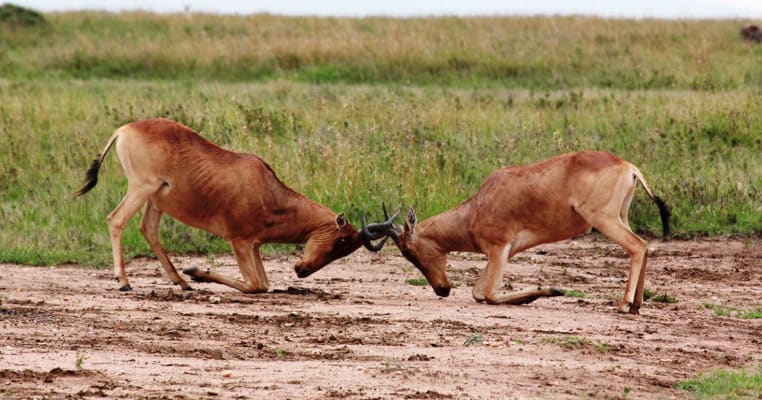[Epistemic status: underinformed musings; I am posting this not because I am sure of anything in it but because the point seems important and I don't recall seeing anyone else make it. Maybe that's because it's wrong.]
A common analogy for the relationship between postulated superhumanly-smart AIs and humans is the relationship between humans and chimpanzees. See, e.g., https://intelligence.org/2017/12/06/chollet/ where Eliezer Yudkowsky counters various arguments made by François Chollet by drawing this analogy.
It's pretty compelling. Humans are a bit like chimps but substantially smarter ... and, lo, humans control the future of life on earth (including, in particular, the future of chimpanzee life on earth) in a way chimps absolutely do not.
But wait. Humans coexist with chimps, and are smarter, and are utterly dominant over them: fair enough. But surely we want to do better than a sample size of 1. What other cases are there where animals of different intelligence levels coexist?
Well, for instance, chimps coexist with lions and leopards. Are chimp-leopard relations anything like human-chimp or human-leopard relations? So far as I can tell, no. Chimps don't appear to reshape their environment radically for their own purposes. When they encounter other animals such as lions and leopards they not infrequently get killed.
In general I'm not aware of any pattern of the form "smarter animals consistently face no threat from less-smart animals" or "smarter animals consistently wipe out less-smart animals that threaten them" or "the smartest type of animal in any area controls the whole local ecosystem".
(I am not an expert. I could be all wrong about this. I will be glad of any corrections.)
What all this suggests, at least to me, is that what's going on with humans and chimpanzees is not "smarter animal wins" but something more like "there is a qualitative difference between humans and other animals, such that animals on the smarter side of this divide win against ones on the less-smart side".
There might be a similar divide between us and our prospective AI overlords. I can think of various things that might turn out to have that effect. But so far as I can tell, it's a genuinely open question, and if there's some reason to be (say) 90% confident that there will be such a divide I haven't seen it.

When presenting claims that the cognitively superior agent wins, often the AI safety community makes an analogies with 2-player zero-sum games such as Chess and Go where the smartest and most ruthless players prevail. However, most real-world interactions are best modeled by repeated non-zero-sum games.

In an ecological context, Maynard Smith and Price introduced the Hawk-Dove game to try to explain the fact that in nature, many animals facing contests over scarce resources such as mates or foods engage in only limited conflict rather than wiping out rivals (Maynard Smith and Price, 1973); for example, a male stag will often yield to a rival without a fight.
When we model how hard-coded strategies for this game propagate via genetic reproduction in a large well-mixed population, it turns out that, for certain payoff structures, peaceful strategies ("Doves") co-exist with aggressive strategies ("Hawks") in a stable equilibrium (see https://sphelps.net/teaching/egt.html for illustrative numerical simulations).
The Hawk-Dove game is also sometimes called "the Chicken Game" because we can imagine it also models a scenario in which two opposing drivers drive on a collision course and simultaneous choose whether to swerve or drive straight. Neither player wants to "look like a chicken" by serving, but if both players drive straight they crash and die.
In the Chicken Game, cognitive superiority does not always equate to winning. For example, by pre-commiting to driving straight and making this common-knowledge we can beat a rational opponent whose best response is then to swerve. Similar arguments were put forward during the cold-war to argue for removing rational deliberation from the decision to retaliate against a first strike by the enemy by removing humans from the loop, and putting strategic weapons systems on hair-trigger automated alert, because in the absence of pre-commit a threat to retaliate is not credible since there is no aposterior advantage to retaliation once the opponent actually strikes. Notice that this dynamic is the exact opposite of the power-seeking behaviour posited by reinforcement-learning agents which seek to maximise expected utility by expanding their possible choices. With non-zero-sum games, in contrast, it can make sense to reduce one's choices. Moreover, the cognitive capacity required to enact policies over reduced choices is lower - stupid can beat smart.
Although Maynard Smith and Price originally formulated the logic of animal conflict in terms of evolutionary adaptation, the same dynamic model can be used to model social learning by boundedly-rational agents (see Phelps and Wooldridge, 2013 for a review). As regards the cognitive capacity of non-human animals to deliberate in Hawk-Dove interactions, see Morikawa et al. (2002).
References
Morikawa, T., Hanley, J.E. and Orbell, J., 2002. Cognitive requirements for hawk-dove games: A functional analysis for evolutionary design. Politics and the Life Sciences, 21(1), pp.3-12.
Phelps, S. and Wooldridge, M., 2013. Game theory and evolution. IEEE intelligent systems, 28(04), pp.76-81.
Maynard Smith, J. and Price, G.R., 1973. The logic of animal conflict. Nature, 246(5427), pp.15-18.